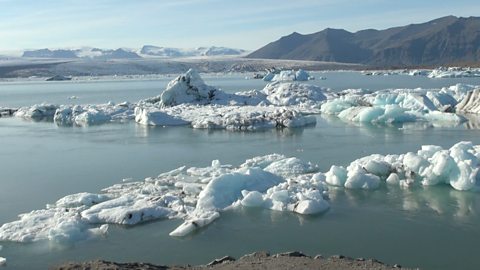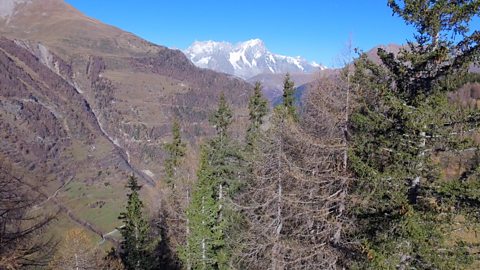Exploring grasslands in Africa to examine the plants and animals living in the tropical savanna biome.
The video
You may have seen lions, elephants and snakes in the zoo but if you wanted to see these incredible animals in their natural habitat you’d need to visit a tropical grassland, or a savanna.
These animals are best adapted to vast expanses of grassland with scattered trees, where the climate is hot, year-round. Savannas cover almost half the surface of Africa and large areas of Australia, South America and India.
So what makes a savanna special? One important factor is they have a wet season, lasting for about six months of the year. During this period the majority of the rainfall for the year occurs - reaching 1200mm. If the rainfall for the year was evenly distributed the area would become a tropical rainforest. In the African savanna region October signals the beginning of the dry season and - ironically - Mother Nature marks this with a series of violent thunderstorms, followed by a strong, dry wind.
Fires are widespread by January, which cooks up grub - such as stick insects and grasshoppers. Larger animals are usually able to run fast enough to escape the fire and can feast on the insects and animals that have been killed.
Another benefit to the fires is that the ash provides nutrients to the soil, that gets washed in by the rains. Fires clear away dead grasses and a flush of new life is experienced.
The trees found in these biomes across the globe have to cope with long periods of drought and fire, which wouldn’t be ideal conditions for your average horse chestnut. Fortunately trees - such as this baobab - have adapted so that it can grow up to 25m tall and live for thousands of years. The Sunland Baobab in South Africa is thought to be 6000 years old! It adapts to the environment, remaining leafless for 9 months of the year. Water is stored from the wet season in its bulbous trunk. It’s thick, corky bark resists fires - clever, eh?
Similarly, grasses have adapted to save their bacon. Some are bitter-tasting, to stop animals from grazing on them. And many - such as Bermuda grass - grow with long roots from the bottom up, so that the growth tissue doesn’t get damaged by peckish animals or fires.
A lion may be the first savanna animal you think of. Its dirty beige-coloured fur provides perfect camouflage for sneaking up on prey and they can run up to 40mph to catch gazelles, buffalo and zebra. Their sharp teeth and claws are perfect for grabbing and chomping up dinner!
The world’s deadliest snake also likes to call the savanna home. The black mamba can grow up to 4.5m in length - that’s nearly the length of two full-sized football goals! And it can travel at speeds of up to 12mph! Keep well away though - you wouldn’t want to get close!
One animal that doesn’t mind getting close to it is the mongoose, which will eat baby black mambas for breakfast! It’s curved and sharp claws help them to dig for food. Its loose, dense fur acts as armour and its colour blends in with the surroundings. In fact, they pretty much have an in-built survival kit!
Humans use savannas as a source of food, as well as for fibre and wood production. They mine extracts of valuable minerals from parts of the savanna and have transformed savannas into national parks, tourism areas and urban developments. Some parts are used for animal grazing.
It’s a spectacular, deadly world in the savanna - where all the plants and animals have finely tuned their survival tools to play their part in the ‘circle of life’. I don’t fancy my chances against this lot though!
Video summary
Download/print a transcript of the video.
Focusing on tropical grasslands in Africa, along with its plants and animals.
Ferne Corrigan looks in-depth at the climate of the African savanna grasslands, describing the rainfall distribution and the benefits of fires in the dry season.
The adaptations made by the baobab tree to survive in the Savanna are explained.
The focus then shifts to the unique features of different types of grass, along with the survival skills developed and adaptations made by lions, the black mamba and the mongoose.
A final look is taken at how humans have used the savanna grasslands.
This clip is from the series Ecosystems and Biomes.
Teacher Notes
Key Stage 3
This could be used to introduce students to the ecosystem of the tropical savanna and how people, plants and animals adapt to the conditions.
The first 30 seconds could be used within a weather and climate topic to describe the climate of the region.
Students could be given a list of plants and asked to decide which ones would be best suited to survive in these conditions.
Students could look at the impact humans have had on the ecosystem and whether we are doing enough to conserve these regions.
Key Stage 4
This could be used to refresh students knowledge of the ecosystem of the tropical savanna and how people, plants and animals adapt to the conditions.
The first 30 seconds could be used within a weather and climate topic to describe the climate of the region.
Students could be given a list of plants and asked to decide which ones would be best suited to survive in these conditions.
Students could look at the impact humans have had on the ecosystem and whether we are doing enough to conserve these regions.
This clip will be relevant for teaching Geography at KS3 and GCSE.
This topic appears in OCR, Edexcel, AQA, WJEC KS4/GCSE in England, CCEA GCSE in Northern Ireland, Progression Step 4/5/GCSE in Wales, and SQA National 4/5 in Scotland.
How animals have adapted to live in the Arctic tundra. video
How people, animals and plants have adapted to survive the harsh Arctic tundra biome.

How animals have adapted to live in the Italian Alps. video
How plants, animals and people have adapted to an Alpine mountain region of Italy.

How animals have adapted to live in the polar biome. video
How animals have adapted to survive the freezing conditions of the polar ecosystem.
